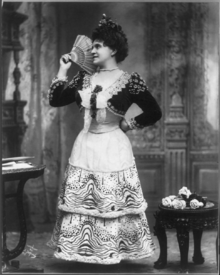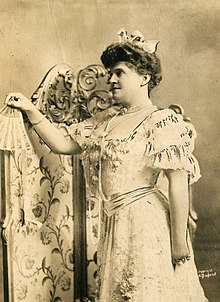Marcella Sembrich



Prakseda Marcelina Kochańska (February 15, 1858 – January 11, 1935), known professionally as Marcella Sembrich, was a Polish
Early life
Sembrich was born at
Education
While at the
Career
After less than a year of study with the younger of the two Lampertis, Sembrich made her debut in opera at Athens as Elvira in Bellini's I puritani on June 3, 1877. She sang not only I Puritani, but also Dinorah, Lucia di Lammermoor, Robert le diable and La sonnambula! It is a testament to her proper early training and intelligence that a 19-year-old soprano could learn so many roles in a foreign language so quickly. Her letters indicate that she could speak English, Polish, German, French, and Italian.
That year she also she married her piano teacher, Wilhelm Stengel. When in Athens, she first appeared under the name “Marcella Bosio”, because she felt that her last name was too hard for audiences to pronounce. Not long after she opted to adopt her mother's maiden name, Sembrich, instead.
While her success was solid, she still had much to learn. After Athens she was to appear with the
After a long and frustrating search for an opera engagement, she was hired as a guest at the
In 1883, Sembrich went to the United States to sing in the newly founded
Sembrich returned to the Met in 1898. In total, she sang more than 450 Met performances in her 11 seasons there, and remained associated with the company until 1909, when the silver jubilee of her Met debut was celebrated with a farewell gala.
She gave recitals until 1917. Sembrich would often end her recitals with piano or violin performances. Many that knew her claim that her experience with the violin made her a sensible and instinctual singer. The diva also made it her mission to promote Polish art as much as possible; her concerts almost always featured a piece by a
The outbreak of World War I had made it impossible for the diva to return to her beloved Alps during the summers. Sembrich turned instead to the Adirondack Mountains area and spent summers at Lake Placid from 1915 to 1921, and then at a home on Lake George from 1922 to 1934. The Marcella Sembrich Opera Museum can be found at Bolton Landing, New York. The museum contains many mementos from the diva's career.
Death
Sembrich died on January 11, 1935, at her home, 151
Reception
Sembrich's 1883 Met debut elicited praise from all who heard her. The New York Truth called Sembrich "an artist of the foremost rank among the living". The New York Journal dubbed her "queen of the opera season so far. Her Lucia is a marvel of voice, execution and magnetism. [She] sings deliciously. There seemed to be no limit to her vocalization: notes run out like pearls falling into a casket with infinite richness, and apparently no effort."[11] Until her retirement at the end of the 1908–09 season, Sembrich captivated audience after audience. Her farewell gala and performance, one of the most lavish farewells in Met history, sold out within two hours of going on sale.[11] At the gala, Sembrich's first entrance was met with a standing ovation lasting several minutes.
The Victor Recordings
Recorded in 1908–1919, the Victor Recordings feature Sembrich's renditions of arias from Rigoletto, Lucia di Lammermoor, Semiramide, Linda di Chamounix, I Vespri Siciliani, The Merry Widow, Ernani, La Traviata and Waltz Dream. [12] James Camner, in his review of the album in Opera News, notes that Marcella was "past her prime" when recording technology came to popularity, but she was still one of the first of her time to produce full-length albums.[13] But more important, according to ARSC Journal, is the access to her recordings. Richard LeSueur, reviewer for ARSC Journal, states that her recordings may have been controversial at the time, but it provides a broader picture of her art.[14]
Legacy
Following her passing, the New York Times and The Musical Times[15][16] gave Sembrich obituaries that highlighted her time in the spotlight of the opera world. Fans across the world mourned her death and the loss of one of the great artists of the time; The New York Times states "her death removes one of the last remaining artists from the rapidly thinning ranks of those who form a link with the great traditions of the past. Fortunate are those who remember her in her days of artistic affluence."
Off stage, she was a dedicated teacher and philanthropist, highlighted below:
- Over the summers Sembrich would retreat to her studio on Lake George in Bolton Landing, New York. She would house and host her students for the summer while they continues their studies with her. Today the studio serves as The Marcella Sembrich Opera Museum[17] and contains many mementos from the diva's life.
- She made a substantial impression on both her teachers and students. Her former teacher Lamperti, dedicated his book about the art of singing to her.
- She was a great Polish patriot and humanitarian throughout her life. During Polish culture in New York City, annually holds the "Marcella Sembrich Voice Competition". The competition is open to singers up to the age of 35 who are not under professional management. The American Council for Polish Culture [ACPC] also honors Sembrich with an annual vocal competition for singers of Polish descent, the "ACPC Marcella Kochańska Sembrich Vocal Competition". She also had organized concerts and activities to raise money for victim of the San Francisco earthquake.
- Two portraits of Sembrich, one in costume, were painted in 1899 by the Swiss-born American artist Adolfo Müller-Ury (1862–1947) but are now lost. Her 1936 portrait by Alice Ruggles Sohier (1880–1969) now hangs in the Metropolitan Opera House (and can be found near the coat room). She also made a number of acoustic recordings prior to World War 1 for both Columbia Records (1903) and the Victor Talking Machine Company. Although these fail to do justice to her voice and undoubted artistry, they have been reissued on CD and repay careful listening.
- The Sembrich in Bolton Landing has Announced 2020's Summer Festival, titled "20/20 Musical Visionaries" . The festival will feature a Tribute to Marcella Sembrich.
See also
- List of Poles
References
- ^ New York Times. January 12, 1935.
- ISBN 0-486-24523-3
- ^ "archives.nypl.org -- Marcella Sembrich papers". archives.nypl.org. Retrieved 2020-10-04.
- ^ The Biograph and Review. E.W. Allen. July 1879.
- ^ "SHIGO VOICE STUDIO: THE ART OF BEL CANTO". SHIGO VOICE STUDIO: THE ART OF BEL CANTO. Retrieved 2020-10-04.
- ISBN 978-0-19-974465-7.
- ISBN 978-1-57467-147-6.
- ^ "Marcella Sembrich | Biography & History". AllMusic. Retrieved 2020-10-04.
- ^ Matters, S. (2010, September 27). Marcella Sembrich Opera Museum. Retrieved from https://www.youtube.com/watch?v=IiqgYSBrm3U
- ^ "Marcella Sembrich: Poland's First Opera Superstar". Culture.pl. Retrieved 2020-10-04.
- ^ .
- ^ "MARCELLA SIMBRICH Victor Recordings". Classical Review.
- ProQuest 1788795.
- ^ LeSueur, Richard (Fall 1998). "Marcello, Simbrich: The Victor Recordings". ARSC Journal. 29 (2): 238–239.
- ^ "Marcella Sembrich". The New York Times. Jan 12, 1935.
- ^ "Obituaries". The Musical Times. 1106: 367. April 1935 – via JSTOR.
- ^ "A Voice From the Met's First Season". archive.nytimes.com. Retrieved 2020-10-04.
External links
- The Marcella Sembrich papers, her extensive collection of scores and personal papers, are housed in the Music Division of The New York Public Library for the Performing Arts.
- Website for the Marcella Sembrich Opera Museum
- Discography of Marcella Sembrich on Victor Records from the Encyclopedic Discography of Victor Recordings (EDVR)
- Broadcast audition “Marcelina Sembrich-Kochańska” (cycle “From collection of the rare recordings” by Maxim Malkov – in Russian).
- A photograph of Marcella Sembrich (by Jose Mora)
- Portrait of soprano Marcella Sembrich at a piano, Los Angeles, California, 1930. Los Angeles Times Photographic Archive (Collection 1429). UCLA Library Special Collections, Charles E. Young Research Library, University of California, Los Angeles.
- Owen, H. Goddard (1950). A recollection of Marcella Sembrich. Da Capo Press. ISBN 978-0-306-76141-6.
- “My favorite folk songs” compiled by Marcella Sembrich,
- Marcella Sembrich : Nimbus Records
- Marcella Sembrich :Victor recording 1904-08
- Marcella Sembrich : Victor recording 1908-19
- Stars of the Opera, personal interview with Marcella Sembrich
- The Sembrich Summer Festival 2020

